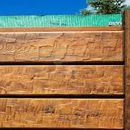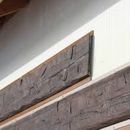What manufacturer makes the best recipe for a cement-based siding for a New England green home?
Is the wood content of fiber cement siding a good thing? What’s its purpose?
Has the recipe for cementicious siding changed from what was used 50+ years ago?
Sometimes I see older cementicious siding shingles cracked and broken. Is this just as likely in time with the new stuff?
Woodtone RusticSeries adds composite to theirs. So you get wood, cement and composite in one product. Unfortunatly the 15yr warranty doesn’t lend much confidence to the product.
Everlogs seem to make a well tested cement product especially for those wanting a more maintenance free log home. They have many white papers and say their product is “Extremly” airtight and a good choice for passive homes. Is the exterior siding layer the most desirable layer to be tight? These Everlogs are being marketed as being packed with Green benefits. Do you experts see them as clearly?
最后,你会寻找最好的Green recipe for a cement based siding for a New England green home?
Thanks
GBA Detail Library
A collection of one thousand construction details organized by climate and house part













Replies
Hal,
Older types of siding were cement-asbestos formulations. These were superior in all respects (except one) to the current wood-based formulations. The problem, of course, is that asbestos fibers are carcinogenic. In any case, cement-asbestos siding takes paint well and lasts forever, as long as you don't hit it with a baseball bat.
There certainly have been problems with fiber-cement products that are wood-based. Early fiber-cement roofing products had a rash of failures. Here are some links if you are interested in learning more about these failures:
http://www.remodeling.hw.net/products/exteriors/imitation-slate-woes
http://docserver.nrca.net/technical/7344.pdf
http://docserver.nrca.net/technical/supr0895.pdf
I would never install a fiber-cement roofing product, but today's fiber-cement siding products aren't suffering many failures. I think that major siding manufacturers (like James Hardie) have come up with formulations that seem pretty good. But it's been a bumpy road to get to where we are today.
Fiber cement isn't particularly green. We looked into it when planning our new house. James Hardie has a premium product, i.e. more expensive, that looked pretty nice. But we decided, since we were trying to be reasonably green, to use locally produced white cedar shingles from Longfellow's in Windsor Maine. Nice product and great folks to deal with. Material cost was a lot less than fiber cement, although installation is more costly.
I gave up on fiber cement years ago. Not a product I would encourage the use of for a variety of reasons. Living in New England, as Stephen says, you have access to many locally-harvested wood siding choices If you're set on a synthetic, I'd recommend LP Smartside over and FC product. Several people I know in various parts of the country, who were nationally-recognized experts on FC (to the point that manufacturers want to them for advice) have switched to Smartside over the years.
Among the issues with FC siding is the special tools needed for, and dust from, cutting and the fussiness of blind-nailing install. Smartside has neither issue - cuts and installs like wood.
Allura is a good product. Check it out. Google it.
http://www.allurausa.com
On the specific questions about the smartlog product, I didn't see where they said it was airtight, but I would think that the plan would be to make the other layers in the wall airtight rather than the siding, as with any other siding. Where the airtightness benefit would come in would be if you are set on a log-look exterior and comparing it to a conventional log wall, which is notoriously hard to air-seal. A conventional wall sided with smartlog siding would avoid that problem and could also be as high in R-value as you want. So if you are set on a log-look exterior, it sounds like a great product.
If you don't want a log look, I agree with Stephen and Dan to go for locally milled wood as a green choice in New England. If you want a rustic look, not necessarily logs, rough sawn wood looks great and holds paint well. Options include board and batten, shingle or clapboard; mostly depending on which look you prefer. Pine and cedar are available; cedar lasts longer and painting it is optional; pine should be painted on all sides to mitigate its tendency to rot.